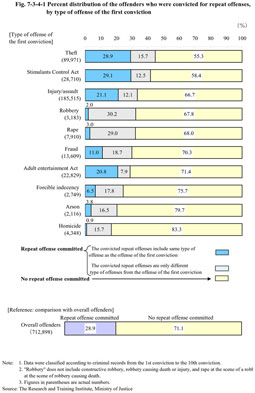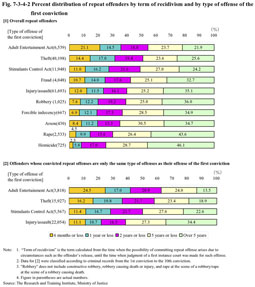| Previous Next Index Image Index Year Selection | |
|
|
1 Offense
As mentioned in Section 2, when it comes to repeat offense prevention measures, how to prevent offenders with a first conviction from being convicted again for the second time is important. This subsection reviews the characteristic traits of repeat offenses by type of offense of first conviction.
Table 7-3-4-1 shows whether the offenders were convicted for subsequent repeat offenses, by type of offense of first conviction, using the 700,000 Non-Repeat and Repeat Offenders' Recorded Convictions. Those convicted for repeat offenses were further categorized depending on whether the repeat offenses they were convicted for include the same type of offence as their first conviction or are only different type of offenses. Offenders with the highest rate of subsequent conviction for a repeat offense were those whose first offense they were convicted for was theft (44.7%), followed by those with Stimulants Control Act violations (41.6%). In regard to these offenses, the rate of offenders convicted for the same type of repeat offense was considerably higher than the other type offenses, with a tendency to repeat the same offense being seen. This tendency can also be seen in the case of those whose offense of the first conviction was injury, assault, or Adult Entertainment Act violations. With offenders whose offense of the first conviction was robbery (excluding constructive robbery, robbery causing death or injury and rape at the scene of robbery/rape at the scene of robbery causing death; hereinafter the same) or rape, the rate of those being convicted for a repeat offense was higher than that of the entire offenders (28.9%), but the rates of those who were convicted for the same type of repeat offense were low at 2.0% and 3.0% respectively. Also, in regard to those whose offense of the first conviction was homicide, the rate of those convicted for a repeat offense was 16.7%, while those convicted for the same type of repeat offense was 0.9%. Both rates were considerably lower than those of other offenses. Upon reviewing the type of convicted repeat offenses by those with robbery and fraud as their offense of the first conviction (they show a relatively strong tendency to commit different type of repeat offenses from the offense of the first conviction), those with robbery show a relatively high rate of theft and injury/assault being their convicted repeat offense (42.9% and 38.9% respectively), while those with fraud shows a relatively high rate of theft being the repeat offense (40.0%) (injury/assault 24.6 %). Fig. 7-3-4-1 Percent distribution of the offenders who were convicted for repeat offenses, by type of offense of the first conviction The term of recidivism will now be examined by type of offense of the first conviction.The term of recidivism can be useful as a reference when considering the period in which intensive supervision/guidance and support will be required in the community. For example, in regard to offenders whose offenses of the first conviction show a high rate of conviction for repeat offenses within a short period, such as six months after being released, there needs to be intensive supervision/guidance and support provided with the focus on such a time period. Table 7-3-4-2 (1) shows the term of recidivism (disregarding the type of repeat offense) with the 700,000 Non-Repeat and Repeat Offenders' Recorded Convictions. In regard to the offenders with Adult Entertainment Act violations, theft, Stimulants Control Act violations and injury/assault as their offense of the first conviction, who show the tendency to be convicted for the same type of repeat offenses, the term of recidivism is reviewed in Fig. 7-3-4-2(2) limiting its scope to those who were convicted for only the same type of offenses repeatedly. Adult Entertainment Act violations have the shortest term of recidivism, with 35.6% of convictions for repeat offenses occurred within a year. This is more apparent in Table7-3-4-2 (2), which limits its scope to those who were convicted for only the same offense of the Adult Entertainment Act violations repeatedly. The rate of those being convicted for a repeat offense within one year was 41.5%. Repeat offenders whose offense of the first conviction was theft or Stimulants Control Act violations also showed a tendency to have short terms of recidivism. In regard to theft, 31.4% were convicted for a repeat offense within one year and 50.8%, which is more than half, were convicted for a repeat offense within 2 years. Moreover, if the scope is limited to those who were convicted for only theft repeatedly, the term of recidivism is shorter, with 36.0% of them being convicted for a repeat offense within 1 year and 57.7% within 2 years. With Stimulants Control Act violations, 27.3% of them were convicted for a repeat offense within one year and 48.9% of them, which is about half, were convicted for a repeat offense within two years. If the scope is limited to those who were convicted for only Stimulant Control Act violations repeatedly, the term of recidivism is shorter, with 28.1% being convicted for a repeat offense within 1 year and 49.8% within 2 years. In contrast, with injury/assault, which also shows a high rate of conviction for repeat offenses like theft and Stimulants Control Act violations, the term of recidivism is relatively longer, with almost 40% being convicted for a repeat offense within two years and nearly 35% within five years. Fig. 7-3-4-2 Percent distribution of repeat offenders by term of recidivism and by type of offense of the first conviction |

